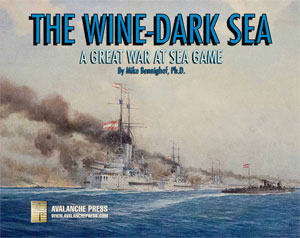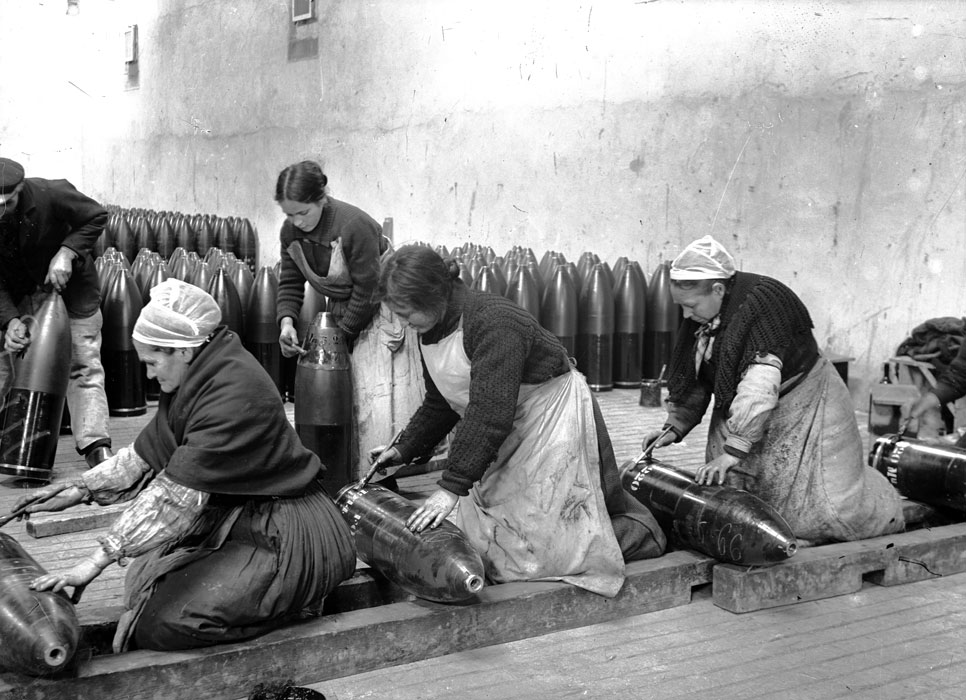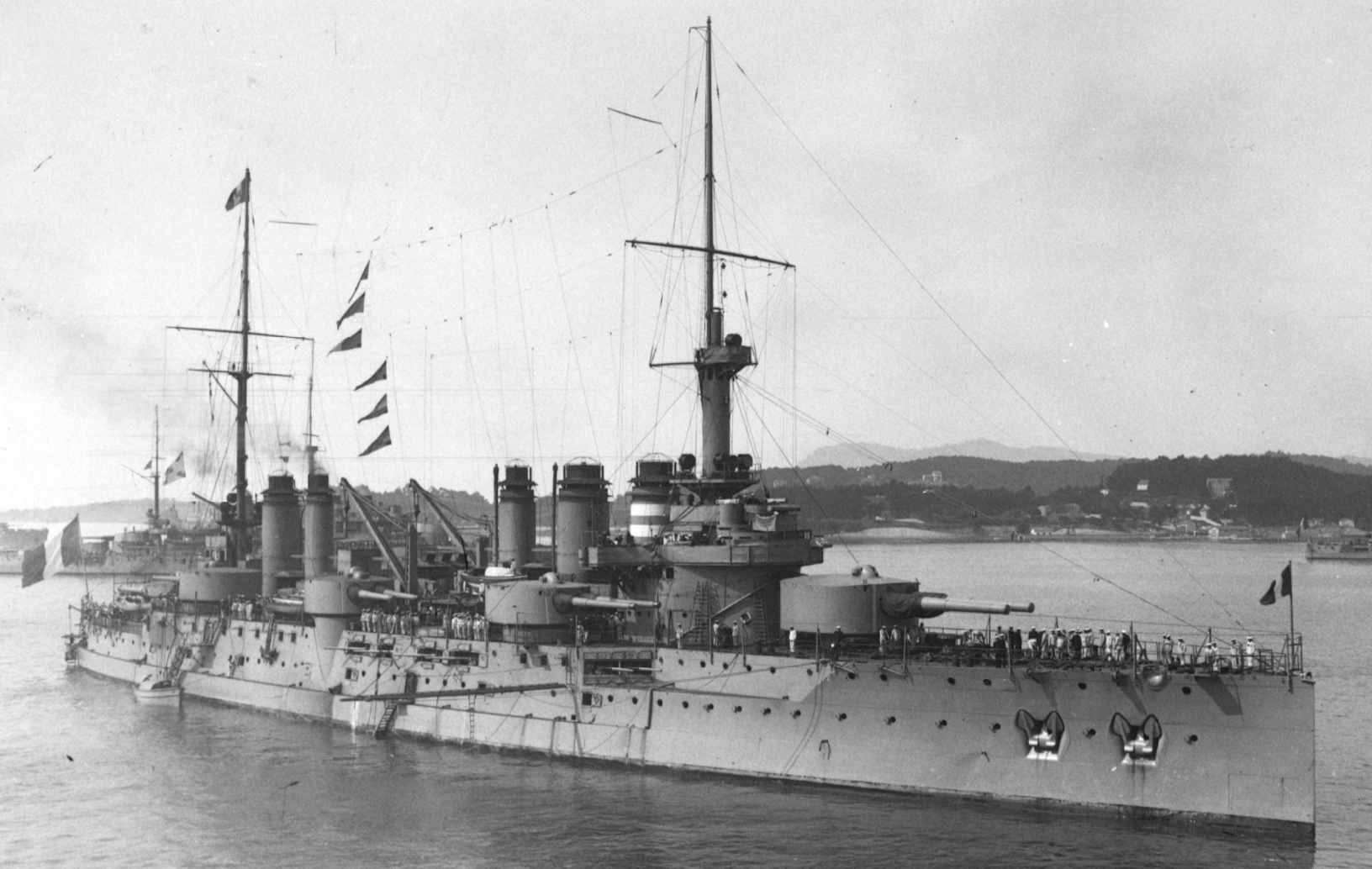| The Wine-Dark Sea:
France’s Semi-Dreadnoughts
By Mike Bennighof, Ph.D.
November 2023
 The German Naval Laws of 1898 and 1900 paved the way for construction of the High Seas Fleet, and in most popular histories their foreign impact is usually described through a British viewpoint. But in France, the prospect of a powerful German fleet steaming down the English Channel to outflank French defenses could not be tolerated. France needed to answer, with a powerful fleet of her own. The German Naval Laws of 1898 and 1900 paved the way for construction of the High Seas Fleet, and in most popular histories their foreign impact is usually described through a British viewpoint. But in France, the prospect of a powerful German fleet steaming down the English Channel to outflank French defenses could not be tolerated. France needed to answer, with a powerful fleet of her own.
That would come in the form of two classes of new battleships, designed to the current international standard: six of the Patrie class, authorized in 1898, and three more of the Danton class (later increased to six), initially projected in 1900 and formally authorized in 1905. Together with the battleships already completed or under construction, that would give France naval superiority over the seventeen battleships foreseen by Tirpitz’s program.
Patrie would reflect the latest thinking, following the results of the Spanish-American War of 1898. A modern battleship needed heavy guns that could penetrate the thickest armor of enemy ships, and rapid-firing, smaller guns to devastate the less well-armored areas of an enemy ship with a blizzard of shells. Patrie would have four 305mm guns in a pair of twin turrets, one forward and one aft, and eighteen 164.7mm guns, in six twin turrets (three along each beam) and six casemate mounts in the upper hull.
The six Patrie class (sometimes divided into two sub-classes) were laid down between 1901 and 1903, and commissioned in 1907 and 1908. All of them saw service in the First World War (except Liberté, which exploded in 1911), and would be scrapped in the 1920’s and 1930’s.

Installing Danton’s forward barbette. Brest Naval Arsenal, 1910.
Design work began on Danton in June 1905; as envisioned, this would be a much-improved version of Patrie with bigger guns, greater size, and new-fangled turbine propulsion. Six months earlier, the British Admiralty’s Committee on Designs had settled on an all-big-gun concept for their next battleship, with a speed of 21 knots. They did not inform their French allies, who continued to unwittingly draft an obsolete ship – the French actually received better information on British design practice from the Japanese (Emile Bertin, France’s chief naval constructor, had trained a whole generation of Japanese naval architects during his time in Japan and maintained many warm relationships with his former students).
Instead of the new Dreadnought, the French naval architects of the Service Technique des Constructions Navale (STCN) drew inspiration from the previous British battleship, Lord Nelson, which would later be termed a “semi-dreadnought.” Lord Nelson had the usual four heavy guns in twin turrets fore and aft, and six additional turrets (three on either beam) mounting ten 9.2-inch guns between them.
Danton would answer that with a pair of 12-inch (305mm) Model 1906 rifles in twin turrets fore and aft. Six twin turrets, three on either beam, would house 9.45-inch (240mm) Model 1906 rifles. In theory, the higher rate of fire from these lighter weapons would give the ship a powerful broadside that included both a large number of lighter shells and a smaller number of heavier ones.
The comparative lightness of the 240mm round bothered both the constructors and the admirals, and the STCN – probably tipped off by Bertin’s Japanese contacts – pointed out that foreign ships armed only with heavy guns might soon appear. The architects offered an alternative ship armed with ten 305mm guns, with six single turrets for 305mm guns replacing the six 240mm mountings.

Manufacturing 240mm HE shells. Ursine St-Nicholas, 1916.
The 240mm Model 1906 had been specifically designed for the Danton class, which would be the only French warships to carry it. Work had begun in 1902 and represented a significant investment. As a compromise, the Artillery Department proposed increasing the size of the 240mm round, which would likewise require re-design of the gun, its supply mechanisms and magazines. It’s difficult to see how this saved money, but the Navy Ministry accepted the proposal. The ship would be a semi-dreadnought rather than one armed solely with heavy guns.
The 240mm gun’s rate of fire did not allow it to be used for defense against enemy torpedo boats, and the new battleship would also need a lighter weapon. That would come from sixteen 75mm Model 1908 guns, another weapon designed exclusively for Danton. This was a long-barreled, high-velocity weapon; all of them were mounted in casemates. Another eight 47mm Hotchkiss guns, fairly useless for their intended role, were also mounted on the ship. Rounding out the ship’s weaponry were two submerged torpedo tubes.
The Navy Ministry also wanted speed, at least 20 knots, an increase over the 18-knot top speed of Patrie. This could only be obtained, the STCN argued, by reducing armor protection, which the Ministry refused. Or, the French parliament pointed out during budgetary discussions, they could use turbines rather than VTE triple-expansion engines. This untested technology had been used successfully in the British Dreadnought, and the French politicians feared that the Marine Nationale was being left behind with outmoded machinery.
For the same space and weight, turbines could provide 30 percent more power and endurance; they could not, however, operate in reverse. They also would cost slightly more than three times what the comparable VTE engines would cost. Damning cost overruns, the new battleship would sport turbines, but still only made 19.25 knots compared to 21 knots for Dreadnought.
Armor protection would actually be weaker than in Patrie, thanks to the increased weight of the new, heavier armament. Danton would be the first French warship with anti-torpedo protection, though it was designed to defeat the relatively small warheads of contemporary torpedoes and might not have fended off the bigger fish deployed by the time of the Great War.
Debate over the propulsion system, re-design of the hull to accommodate it, modifications to the heavy guns (both 305mm and 240mm) and re-design of turrets and barbettes thanks to those modifications, all combined to delay the start of construction. Three ships were laid down in 1907, and three more the following year. By the time the last of them, Vergniaud, began construction in July 1908, the British had completed Dreadnought, launched three sister ships, and laid down three more. All six would be completed between July and December 1911; by that point, Britain had commissioned ten dreadnoughts and even the Germans, very slow to adopt the new type, had completed six of them.

Voltaire seen at Toulon.
All six of the Danton class served in the Mediterranean during the First World War. The turbines performed well, once early difficulties had been overcome, and the ships were notably stable gunnery platforms. In theory they could generate heavy firepower at short ranges, but as the range increased their accuracy fell off and spotters had difficulty distinguishing the fall of shot from the two different calibers of main gun.
A German submarine sank Danton herself in 1917. Mirabeau ran aground in the Black Sea in February 1919 and though she returned home, she was never repaired. Vergniaud, in poor physical condition, was deleted in 1921 and scrapped in 1926 after several years as a target ship.
Under the terms of the Washington naval limitations agreement, the Marine Nationale could keep the remaining three ships and modernize them. Those three ships underwent work in the 1920’s, receiving new underwater protection but not a thorough reconstruction; their obsolete design limited what could be done with them. Diderot and Voltaire spent the next decade as training ships before they were scrapped. Condorcet also spent time as a training ship before becoming a stationary school ship and finally a barracks for German sailors during World War II. The Germans scuttled her in 1944 and she was broken up after the war.
Political considerations, and sheer bureaucratic inertia, prevented the Marine Nationale from taking the obvious decision and cancelling the Danton class before construction began. At that point, the British had unveiled Dreadnought and the French ships’ obsolescence couldn’t be overlooked. The all-big-gun version might have been a marginally better fighting ship, but that too had been surpassed by British, American and soon German ship designs.
Click here to join the Gold Club
See your Gold Club Insider newsletter for ordering information.
Sign up for our newsletter right here. Your info will never be sold or transferred; we'll just use it to update you on new games and new offers.
Mike Bennighof is president of Avalanche Press and holds a doctorate in history from Emory University. A Fulbright Scholar and NASA Journalist in Space finalist, he has published a great many books, games and articles on historical subjects; people are saying that some of them are actually good.
He lives in Birmingham, Alabama with his wife and three children. He will never forget his Iron Dog, Leopold. Leopold needed no revisions.
Want to keep Daily Content free of third-party ads? You can send us some love (and cash) through this link right here.
|
